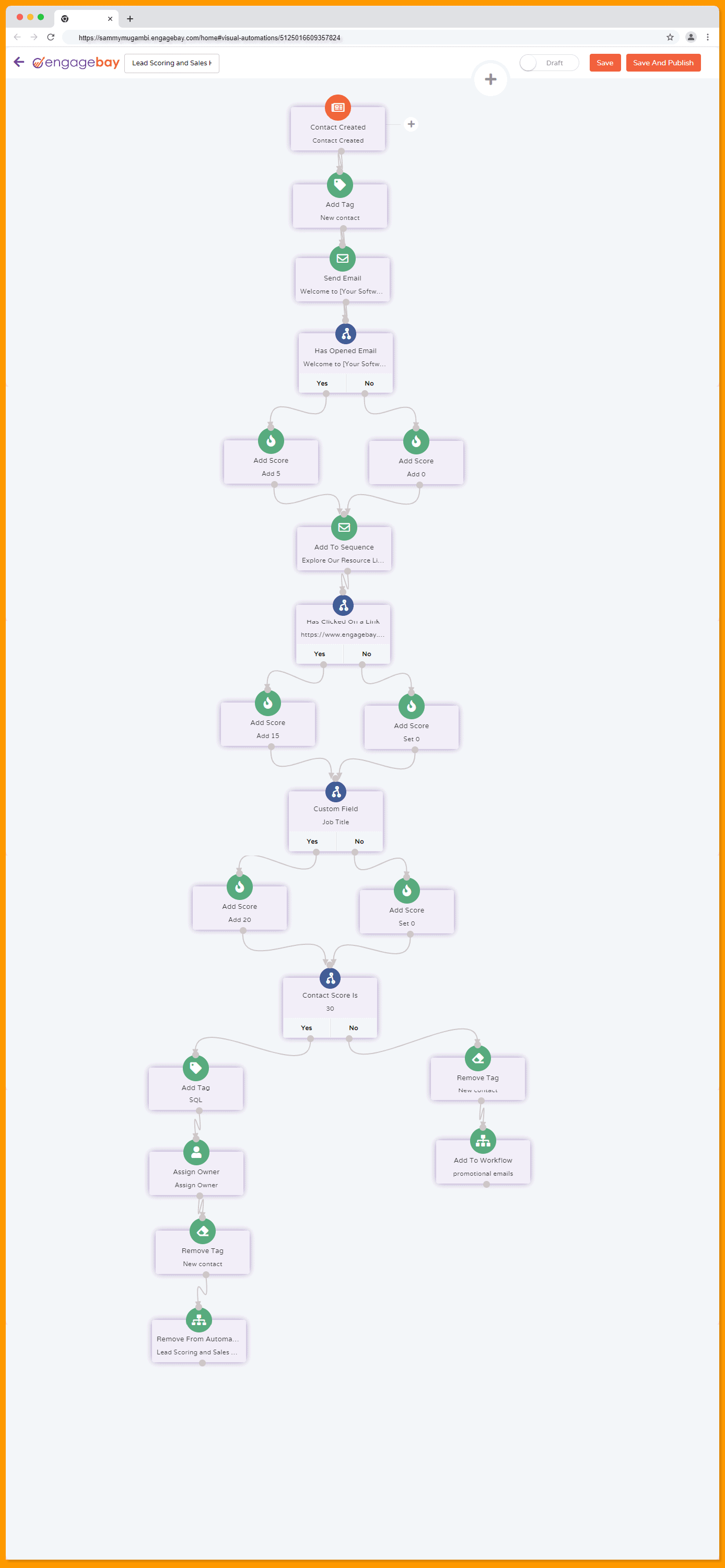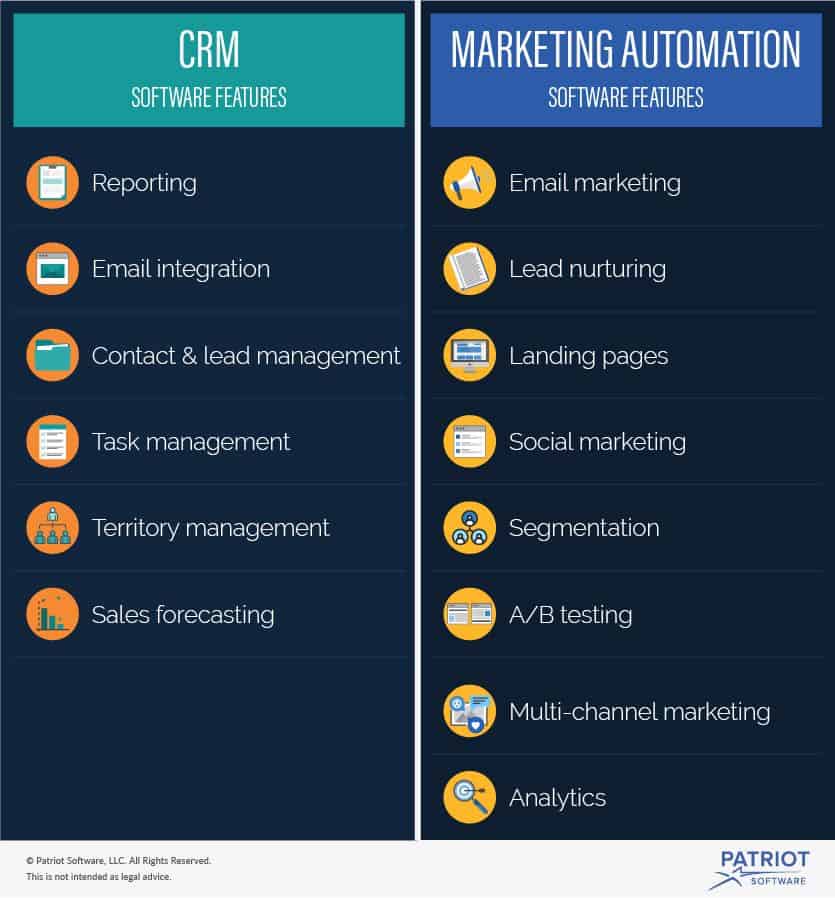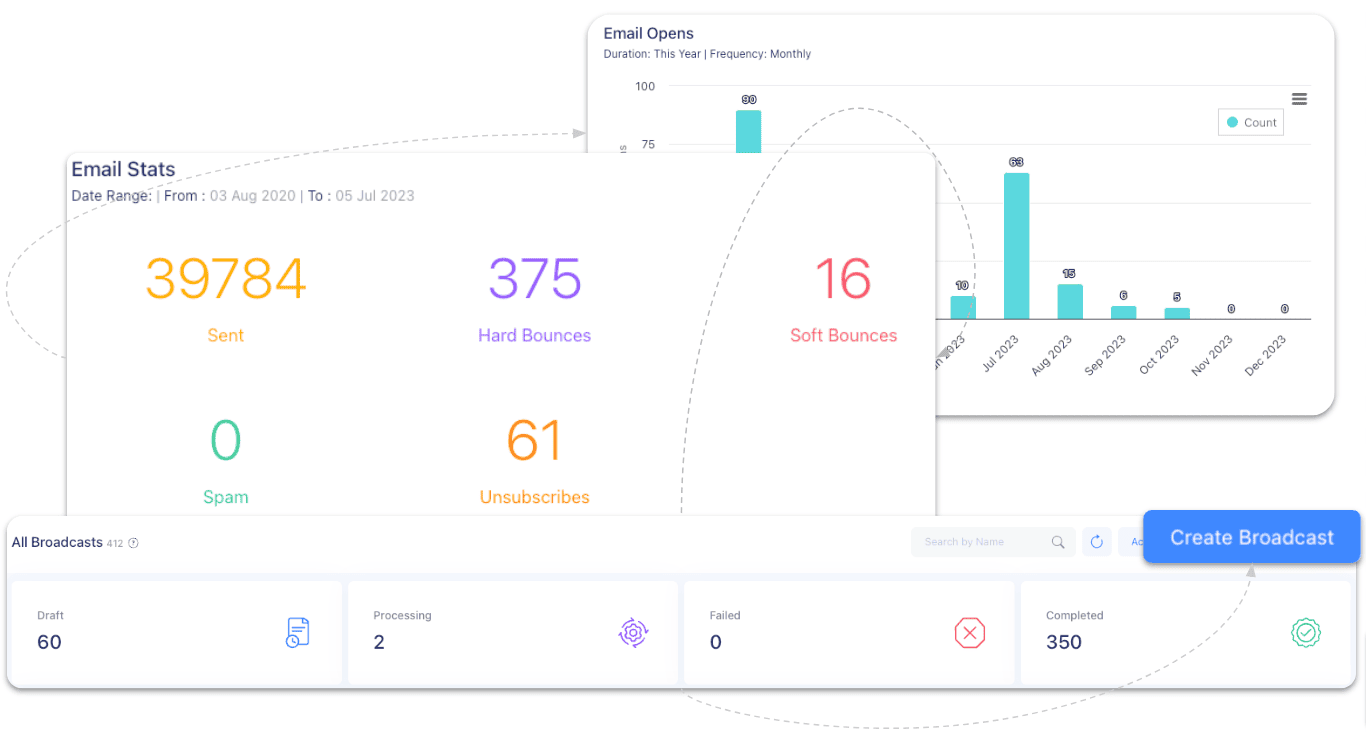CRM and marketing automation integration is a well-defined process that combines and improves the alignment between marketing and sales activities. It lets businesses automate prospecting, data entry, customer management, and other time-consuming business operations.
Since CRM systems provide a centralized location for customer data, seamless integration with marketing automation platforms allows marketing teams to create smart segments, nurture leads, and run targeted campaigns to increase reach and boost engagement.
In this article, we share what you need to know about CRM and marketing automation integration, key features, and proven implementation strategies for building lasting customer relationships.
Table of Contents
Overview of Customer Relationship Management (CRM)
Customer relationship management (CRM) refers to businesses’ practices, strategies, and techniques to track, process, and analyze customer data. It involves the guidelines and technologies that help companies manage customer interactions and communications throughout the customer lifecycle.
A CRM system gathers customer data from multiple sources and consolidates it into one location. Afterward, the sales team uses the data to qualify leads, nurture relationships, and improve sales by offering optimized customer experiences with valuable insights.
Ultimately, CRM platforms are designed with powerful capabilities that let organizations monitor and analyze customer data to produce real-time reports and insights into customer behavior and actions across the brand. This enables brands to understand their customers better.
Overview of Marketing Automation

Marketing automation refers to companies’ technologies, processes, and techniques to handle simple, routine marketing operations on autopilot. It includes several processes that allow businesses to manage repetitive, time-consuming, and mundane tasks without the need for human input.
Brands that automate their marketing tasks use specialized platforms to eliminate manual data entry, redundancies, data errors, and other risks associated with manual processes. These steps let them optimize their marketing campaigns, deliver targeted experiences, and improve personalization across all channels.
Marketing automation tools offer pre-built automated workflows and email series, lead scoring, email list segmentation, campaign management, landing pages and forms optimization, A/B testing, etc. These functionalities enable marketers to tailor appropriate, relevant, and timely campaigns to the right audience.
Read also: Everything You Need to Know About CRM Integration
How Do CRM and Marketing Automation Complement Each Other?
Although customer relationship management (CRM) and marketing automation have varying processes and functionalities, they form a powerful system for enhancing business operations when combined together.
The customer journey involves several stages that take your users from potential buyers to loyal and repeat customers. Generally, each stage may require specific actions from one or more departments in your organization – mainly the marketing, sales, and service departments.
CRM systems are usually sales-focused. They allow businesses to track customer interactions and communications. This provides valuable reports that enable them to understand buyer behavior and preferences and create strategies to win new leads and retain existing customers.
The systems offer useful features for enhancing sales, managing customer information, facilitating customer retention, etc.
On the other hand, marketing automation is marketing-focused. The systems enable businesses to automate their marketing processes to run optimized campaigns and reach a wider audience. Marketing automation combines several marketing channels to help businesses tailor the right messages to their audiences, regardless of the platform they use.
The best of both worlds
Combining CRM and marketing automation means bringing sales and marketing teams together to improve the sales cycle, boost customer engagement, and give the customer a pleasant buying experience.
When both systems work independently of each other, getting the required data to handle each process can be challenging since they work in progressive succession. For instance, after a campaign, the marketing team shares their data with the sales team, compiling their generated leads and contacts.
Proper lead nurturing and scoring help the sales team find qualified leads, thus improving pipeline management and the sales cycle. Since customer information is stored in the CRM database, marketing teams can use it to improve their marketing campaigns by placing contacts in different segments based on their behavior, preferences, interests, and other predefined criteria.
A seamless integration of these systems gives businesses a complete view of the customer regardless of the buying stage.

Read also: Top CRM Marketing Automation Tools for Business Efficiency
Benefits of Integrating CRM and Marketing Automation
Businesses that use customer-focused techniques require real-time, complete data to build healthy relationships and improve customer satisfaction.
As we have shared earlier, here is a more detailed list explaining why brands should consider CRM and marketing automation integration.
1. Improved customer insights
Valuable reports and insights from customer data can help companies spot specific patterns and trends in customer behavior. This data can influence their decisions and strategies.
So, with real-time, accurate, and complete data from both systems, businesses can fully understand why users take certain actions. This will enable them to make unique offers tailored to their customers’ needs.
2. Optimized marketing campaigns
Marketing teams run several campaigns to reach a wider audience and generate more leads. However, getting timely and relevant messages to the right audience can be challenging since your audience comprises individuals with varying needs and interests.
Ordinarily, marketing teams have limited information about new or existing customers, so they’d need data from the CRM database to create segments. These segments will help them write engaging content based on predefined attributes and characteristics to suit the right audience.
3. Enhanced personalization
Personalization thrives on real-time, complete, and consistent data. These systems, functioning separately, can lead to data silos, and different departments may not have consistent or sufficient information to personalize their communications with customers.
But with an integrated system, team members can have a complete view of customers, understand their peculiarities, and provide tailored offers that appeal to them. For example, if the marketing team discovers that certain audience segments are athletes, they will promote more sportswear and equipment to them. This also helps them keep their messaging consistent across all channels.
4. Proper lead management and nurturing
As your CRM gathers large amounts of customer data, you can easily sort and organize them to identify cold, warm, and hot leads. This valuable piece of information will help your marketing team create the right strategy to nurture these leads and increase conversions.
Marketing automation can help you deliver trigger emails as the leads reach specific touchpoints. This streamlines your onboarding process and moves cold leads to hot leads ready to buy.
5. Improved team collaboration
CRM and marketing automation integration enhances team collaboration as both teams can use shared customer data to craft successful strategies and improve business operations. Customer data shared across teams reduces the risk of creating data silos.
Also, the CRM consolidates customer data into a single unified dashboard where managers can easily update or modify the information as customers’ needs evolve.
Read also: 9 Amazing Marketing Automation CRM Software [Comparison Table]
Key Features of an Integrated CRM and Marketing Automation System
Businesses combining CRM and marketing automation use unique functionalities to deliver enhanced results and ensure seamless integrations. In such an integrated system, here are specific features you may find.
1. Data synchronization
The most important feature of an integrated system is its ability to combine data from multiple sources across several departments to make it consistent and accessible in a single unified dashboard.
Data synchronization consolidates data across various applications or devices to maintain consistency when data is updated or modified. As you adopt CRM and marketing automation integration, ensure data is adequately synchronized to enable access to different departments for optimized operations.
2. Automated workflow management
The efficiency of a CRM and marketing automation system depends on the strategies employed to streamline your workflows and reduce manual processes. These systems offer numerous functionalities that require simple and complex processes.
Usually, many of these processes are time-consuming and repetitive. Also, transferring data from one source to another can be daunting, so your integrated solution should offer well-built workflow automation systems that allow you to reduce manual input, giving you more time to handle more critical business tasks.
Additionally, you can enhance your workflow using an employee time tracking app to optimize resource allocation and enable better focus on essential business operations.
3. Segmentation and targeting capabilities
In a customer-centric strategy, businesses target users based on their unique attributes and characteristics to give them tailored and personalized experiences. An integrated system offers segmentation and targeting capabilities to enhance engagement with the right audience.
CRM data can give you insights into customer behavior and brand interactions. This way, you can craft data-driven marketing strategies to improve your campaigns and increase your reach.
Segmentation works by fragmenting your contacts into smaller units based on predefined criteria. These segments can be targeted with timely and relevant content that appeals to them.
4. Analytics and reporting
A comprehensive reporting and analytics system gives valuable insights into your sales and marketing operations. These reports help you understand customer preferences, behavior, and specific trends that can help you prioritize leads, improve customer segmentation, and enhance targeting.
CRM analytics also collects business performance data and tracks progress over time. Different teams can use the reports to monitor the efficiency of their strategies and see how they can improve collaboration. They can also deliver progress reports, task status, and other helpful information that allows them to optimize their processes.
Read also: Marketing Automation vs CRM: Decoding the Difference
How To Implement a Successful Integration Strategy
While numerous CRM and automation platforms exist, businesses need more than a tool to achieve a functioning integration strategy. Here are some implementation steps.
1. Define your business goals
Integrating a CRM and marketing automation system involves several sophisticated processes that can be tailored to meet different business goals. Small businesses and startups will have different goals and targets from larger enterprises. Likewise, a brand with a larger audience usually requires a more complex plan than one with a smaller audience.
So, your business goals determine what your integration strategy will look like. From the CRM features to price, security, and scalability, you must adopt a suitable system that aligns with your brand values.
2. Identify your target audience
Strategies to target athletes and nursing moms will differ from one to another. Your target audience comprises individuals with closely related interests. So, while implementing your integration strategy, it’s essential to factor in the users you’re targeting, as this will help you tailor your processes to give them optimized and personalized experiences.
Identifying your ideal buyers also includes mapping out a customer journey that shows you the various stages your customers go through before purchasing. This information will enable you to craft a complementary strategy for capturing their attention at the right time and with relevant offerings.
3. Adopt the right tools
Several CRM and marketing automation platforms have varying capabilities and features well-suited for businesses of different sizes, models, and goals. A successful integration strategy largely depends on your tools to organize customer data, manage workflows, and deliver reports.
Generally, businesses use CRM and marketing automation solutions that align with their business goals. You can pick the most suitable tool based on certain criteria like price, features, scalability, ease of use, and mode of operation.
4. Ensure proper staff training and onboarding
Different departments collect and organize customer data in different formats. However, they’re all consolidated into a single dashboard where authorized personnel can modify and update the data.
Team members need adequate training and guidance to build strategies and processes and incorporate CRM systems into their operations. This will ensure consistency in customer data, avoid data duplication, and enhance team collaboration, as different departments can access the information they need to create strategies.
5. Monitor performance and refine your strategies
After defining your goals and choosing the suitable systems for running your campaigns, monitoring your performance over time is crucial. Your first attempt may contain lapses and loopholes, so you should review your strategies and make necessary improvements.
Refining your processes involves conducting strategic tests to see what works and what doesn’t. It also includes tracking key metrics to evaluate the efficiency of your workflows and processes.
6. Gather user feedback
No matter how efficient your system is, you may never know how it impacts your audience until you conduct surveys and gather reviews. Customer feedback helps you see how real users are engaging with your brand.
From the information they share, you can make necessary adjustments to match their interests and optimize your processes to provide the most relevant solution to their problems. You can gather user feedback through survey forms, star ratings, social media polls, etc.

Read also: Cracking The Marketing Automation Process [101 Guide]
Final Takeaway: Crafting a Fail-Proof Integration Strategy
A successful CRM and marketing automation integration plan is not without challenges. As businesses aim to deliver optimized customer experiences, they may face difficulties such as data quality issues, system malfunctions, security breaches, system compatibility, migration issues, etc. Many organizations usually spend much of their budgets fixing these issues and managing challenges, affecting productivity.
Businesses can minimize the chances of encountering these issues by adopting the various implementation strategies explained in this article:
- Define your business goals
- Identify your target audience
- Adopt the right tools
- Ensure proper staff training and onboarding
- Monitor performance and refine strategies
- Gather user feedback
Organizations can build lasting customer relationships as long as they embrace a functioning system that combines the capabilities of customer relationship management (CRM) and marketing automation.
One major platform offering this functionality is EngageBay, an all-in-one CRM platform for sales, marketing, and support teams. Starting at $13/month, you can access well-built features that optimize customer engagement and satisfaction.

